Our latest interview is with Ed Wolcoff who always ran with RT New York and ended up being the 1-0, he spent a total of 25 months in Vietnam.
Modern Forces: Can you tell us about your background and military service?
Ed Wolcoff:
- Entered service in September ‘67
- Graduated AIT as an 11C (Mortarman)
- Airborne qualification March ‘68
- Completed Special Forces training in October ’68. Light Weapons Leader 11B4S.
- Assigned to 6th Special Forces Group – Airborne in October ‘68
- Assigned to 5th SFGA (SOA CCC – MACV SOG) in March ’69 and further assigned to Recon Company.
- Assigned to USA Institute for Military Assistance as Instructor (Recon Division)
- Graduated Operations and Intelligence Course with MOS 11F4S in May ‘72
- Assigned to 7th SFGA in May ’72. HALO qualified in ’72 and Russian Language in ’73.
- Attended Officer Candidate School and commissioned as a Lieutenant in March ‘75
- Attended Explosive Ordnance Disposal School and then assigned as Commander, 28th EODD in 1976
- Assigned to Berlin Brigade in 1980. (Captain)
- Assigned as Company Commander of an ordnance company in 1983 (Germany)
- Assigned as Developmental Test Manager in Yuma Proving Ground, Arizona in Dec ’84 (Major)
- Graduated Command and General Staff College in ’89
- Assigned to Special Weapons battalion as Operations and Materiel Officer in ’89 (Lieutenant Colonel)
- Attended Program Manager’s Course and assigned to the Pentagon (Office of the Assistant Secretary of the Army (Research, Development and Acquisition)
- Retired in May ‘95
Modern Forces: What made you join Special Forces and then apply for SOG, did you know what it was before you joined?
Ed Wolcoff: Found out about SF and something about SOG while I was in college Reserve Officers Training Course (Had three SF advisors). Also heard rumors about SOG while in SF training.
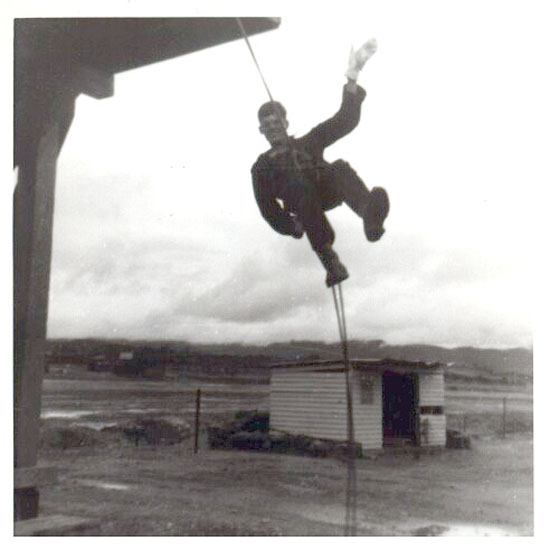
Sgt Tim Lynch (RT Ohio)
Modern Forces: What dates were you with SOG?
Ed Wolcoff: March ’69 through April ’71 (25 months)
Modern Forces: Did you always run with RT New York?
Ed Wolcoff: Yes.
Modern Forces: From the research I have done and photos I have seen RT New York seemed to favour customizing their gear to suit the mission, I would like to explore this in more detail. For example you seemed to favour dyed black jungle fatigues, what prompted this?
Ed Wolcoff: There were many factors involved in customizing gear: mission, seasons (monsoon/dry), weapons and items carried, location/elevation, enemy concentration and personal concept of operations - - some team leaders focused on stealth and the reconnaissance mission, others believed that contact was inevitable and focused on direct action.
I wore black fatigues for two reasons:
- In rain forest, tree trunks are black and the soil is nearly so. So black fatigues were not irreconcilable with camouflage.
- Russian advisors were reputed to wear black. As I was clearly Caucasian, I thought that if I was spotted my appearance as a Caucasian in black may give me a split second’s edge in an encounter - - especially where I and others on my team were carrying Soviet/Chicom weapons.
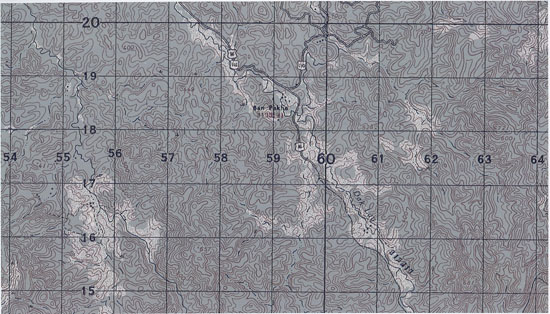
Ban Pakha
Modern Forces: A feature of the custom gear is your webbing or LBE. Can you describe the modifications you made? I thought I would use the content you have already sent via email here but feel free to add more for example what did you carry in your butt pack? What knife did you use?
Ed Wolcoff:
- When I carried the RPD, I also carried 500 rounds of ammo. 100 rounds were in a drum magazine attached to the weapon. 200 rounds were carried in two additional drums in purpose-built pouches on my belt - - I retained the pouch straps to supplement the weight-bearing capability of the belt. I carried 200 more rounds in canteen pouches. The drums took up space on the LBE belt and could be noisy if care were not taken, but the drums kept rounds aligned on the RPD ammo belt; the canteen pouches took up less space on the LBE belt and were silent, but rounds would misalign and cause a stoppage.
- I carried the survival radio next to my ear so that my hands could be free for weapons use.
- I carried a claymore mine in a chest pouch. Quickly deployed from the prone position. Claymore was always dual primed (electric and non-electric) and had a shortened firing wire.
- After my first couple of missions, I abandoned the issue rucksack in favor of lighter gear - - and did not do so on the mission cited. Look at pages 225 and 226 of Jason Hardy’s book “SOG Team History and Insignia of a Clandestine Army V2”. The harness consisted of nylon cloth with two straps to retain the bed roll, and top strapping (with Velcro as I recall) to attach the harness to the web gear suspenders. Both John and I adapted the harness with a claymore ∏-pouch. We were constantly working to improve/adapt our LBE. After I became “1-0”, I abandoned the harness for what we referred to as a butt or fanny pack - - I needed more cargo carrying capacity.
- Butt pack: sleeping gear, booby traps/mines, sabotage materials, food, occasionally a mortar round.
- I carried a meat cleaver. Heavy enough to cut brush; flat blade useful in digging.
- The leggings were also useful in stopping leaches from entering through the boot tops.
- Although you cite the Hanson Rig as a precursor to the Stabo, I never used the Stabo and kept the Hanson throughout.
Modern Forces: Another custom item, well not one I have seen in any US issue lists are the Num Chuks, was this something used on missions?
Ed Wolcoff: Never took num chucks to the field. Personal item. Several of us were simply into martial arts; we could get num chuck manufactured very cheaply.
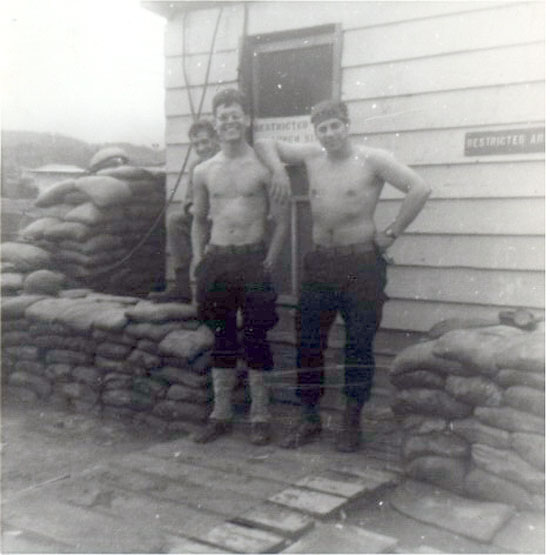
Sgt Lynch & Johnson (RT Ohio)
Modern Forces: There is a picture in Jason Hardys second book ( SOG: Team History and Insignia of a Clandestine Army, Volume 2 ) you and Fat Albert can be seen down the range in ERDL camo. Is this something you ever wore over the fence?
Ed Wolcoff: Never.
Modern Forces: Did you have a weapon choice or preference?
Ed Wolcoff: RPD. I had serious malfunctions occur with the CAR-15 on two occasions in the field; moreover the 5.56mm had lousy stopping power.
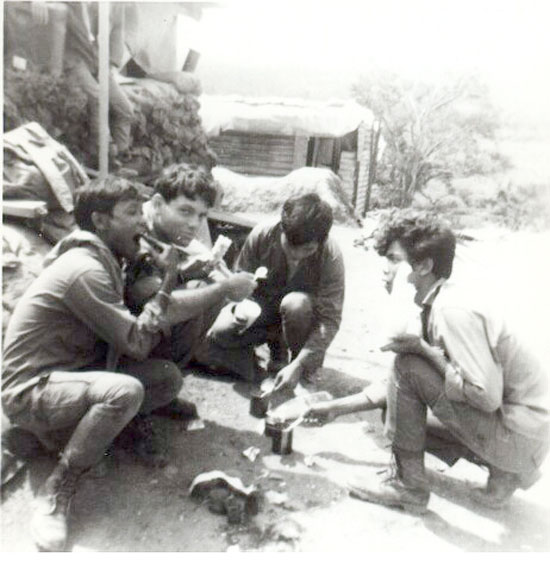
Lunch for RT NY at Dakto
Modern Forces: Did you ever carry a back up weapon, if so what was this?
Ed Wolcoff: Carried a silenced pistol on one operation, but not thereafter. I wanted to carry a backup, but I was already carrying too much weight with a machine-gun with 500 rounds.
Modern Forces: Did Fat Albert (Pete Wilson) always where his shades and a wooly hat/watch cap? As seen on page 234 in SOG: Team History and Insignia of a Clandestine Army, Volume 2?
Ed Wolcoff: Pete Wilson wore his wool had on missions, never knew why. Sun glasses were prescription lenses; he wore clear lenses under rain forest canopy.
Modern Forces: Can you describe the mission where John St Martin was injured?
Ed Wolcoff: Within the past few years, I was able to conclude that the T-7 area was the sanctuary location for the 66th NVA Regiment - - Ho Chi Minh’s favorite and the best in the NVA. RT NY repeatedly inserted into this area thereafter, knowing that a regimental sized bivouac was located there, but without realizing which unit routinely occupied it. Another NVA regiment that was typically paired with the 66th under a division HQ for major operations (e.g. Tet) , was the 28th NVA. This regiment was located in the tri-border area (Northeastern-most point of Cambodia).
The buildings (large, heavy log structures) were entirely too large for a regimental HQ - - NVA regimental staff were few and their needs were minimal. And the enemy would never allocate such premium structures for logistics storage. A single large structure might suggest a hospital, but four such structures in a single compound would suggest a divisional HQ (which would logically be sited near a combat regiment for security purposes), or an area command HQ. Intel gained on our subsequent operations revealed other infrastructure (e.g. underground complex) within 1-200 meters of this compound, which substantiated my view that a major HQ was located at this juncture.
I was not able to bandage St. Martin’s belly wound. I could only pile his intestines back on top of his stomach, tuck in his undershirt and tighten down his belt.
During the extraction, the enemy attacked in far greater strength than a platoon. The covey pilot estimated at least a battalion.
As the helicopters lifted us beyond the tree tops, we came under fire from 22mm and 37mm anti-aircraft guns.
Davis used his M-16, and the pilot used his limited supply of rockets, to drive off the initial enemy assaults as we awaited the arrival of the A1’s and gunships and before the enemy was fully massed for the wave assaults that followed.
Info below taken from two award citations:
On 14 August 1969, Sergeant John St. Martin (SSN XXX-XX-XXXX), Team Leader of Recon Team New York, Military Assistance Command-Vietnam, Studies and Observations Group (MACV-SOG), Command and Control Central (CCC) stationed in Kontum, Republic of Vietnam, led his 8 man recon team in an assault of a North Vietnamese Army (NVA) regimental headquarters located deep behind enemy lines inside Laos. The Target Area was designated Tango-7. The Air Force code name for the operation was “Sad Sam”. I was a Sergeant (E-5) and the Assistant Team Leader of RT New York on this operation.
Late in the afternoon of 14 August 1969, RT New York, while enroute to its reconnaissance target, Laotian Highway 110 (part of the Ho Chi Minh “Trail” complex), encountered a 4-building complex of very large structures, of heavy log construction, located in an open compound but concealed by a high, unbroken tree canopy. Based on the size and construction of the buildings, we estimated this complex to be at least a regimental HQ and possibly an area command (Note: subsequently, three battalion bivouac areas were detected abutting this compound). Upon this discovery, SGT St. Martin, decided to assault the compound in an effort to capture high-ranking enemy personnel and/or documents. We transmitted this intent to HQ, CCC through an O-2 FAC aircraft piloted by CAPTAIN Donald F. Fulton, and were subsequently instructed to withdraw a short distance and attack the compound with tactical air assets, then to move forward to conduct a Bomb Damage Assessment (BDA).
SGT St. Martin moved the team approximately 70 meters from the compound and employed TACAIR assets, assisted by CPT Fulton and CCC air-ground coordinator (SERGEANT FIRST CLASS Howard Davis). CPT Fulton advised that air assets returning from another mission with unexpended ordnance had been summoned to assist. These strike aircraft were equipped with BDU (dispensed bomblets), which were unsuitable for targets under canopy and 500 lb bombs, which would normally not be used in close proximity to our team. SGT St. Martin took responsibility for calling in the strike under extremely hazardous danger-close conditions on an ill-defined target located in densely-vegetated, mountainous terrain, and attempted (unsuccessfully) to adjust the air strike by sound, without marking the team or enemy location, so as not to reveal our exact location to the superior enemy force.
At the conclusion of the strikes, SGT St. Martin moved the team forward to conduct the BDA, although the enemy was alerted to our presence. Observation of the compound revealed that the air strike had been totally ineffective. SGT St. Martin then formed the team into two assault lines of 4 personnel each; the first line consisting of SGT St. Martin, two Montagnards and myself. The second line consisted of SGT John Blaaw (Radio Operator) and three Montagnards. SGT St. Martin directed the first assault line to pull pins on grenades and approach the structures. As the team approached a large fallen tree on the periphery of the compound, the enemy opened fire with automatic weapons, hitting the SGT St. Martin three times and knocking him off the fallen tree into a position of cover. SGT St. Martin’s armed grenade had fortunately dropped on the opposite side of the tree. The remaining members of the first assault team hurled grenades and returned fire, suppressing enemy fire somewhat. I dragged SGT St. Martin to a better location to treat his wounds while the remainder of the team provided covering fire. I discovered that one wound had opened SGT St. Martin’s abdomen, spilling his intestines; the other wounds had shattered his right leg. As dusk fell, I secured the abdominal wound by tucking St. Martin’s jungle shirt into his pants and dragged him to the nearest Landing Zone.
During the team’s withdrawal with the wounded team leader, CPT Fulton made several White Phosphorus rocket attacks and then made continuous treetop level strafing passes while taking heavy ground fire while taking heavy ground fire - - as SFC Davis fired an M-16 from the aircraft window. As night approached, these rocket and strafing attacks helped to delay the advancing enemy force and draw their fires away from the team; but within a few minutes, the enemy had assembled an estimated company-sized force at the edge of the bamboo-covered LZ.
Once SSG Davis had expended all of the M-16 ammunition, Captain Fulton continued to make deceptive strafing passes until TACAIR support arrived at nightfall, just as the enemy was massing to launch their assault. At great risk to himself, Captain Fulton made further treetop level passes to pinpoint the team’s location to USAF TACAIR, helicopter gunships and UH-1D extraction helicopters.
Extraction was conducted at night, in a rainstorm, while team members were suspended from ropes beneath two helicopters, and while the USAF TACAIR, helicopter gunships and UH-1D extraction helicopters were taking small arms, Rocket-Propelled Grenade, 12.7 mm machinegun, 22mm and 37mm anti-aircraft fire. The exfiltration flight occurred in such heavy downpour that the first helicopter (with the wounded St. Martin) missed the launch site at Dakto, and flew all the way to Kontum. SGT St. Martin experienced great loss of blood and extreme pain during the extraction and subsequent flight, yet somehow survived.
The day following the operation, I met with Captain Fulton and SSG Davis and discovered that the O-2 aircraft had taken substantial battle damage and that the aircraft had landed at Plieku airbase with a dry fuel tank.
The Sad Sam operation resulted in the discovery of a major enemy headquarters and nearby main force bivouacs and fortifications, which were subjected to aerial attack and subsequently ground attack by an exploitation force from CCC whereby the enemy sustained heavy losses and was forced to abandon the complex. The Sad Sam operation and subsequent ground operation caused the enemy to reinforce security in its sanctuary area at the expense of main force units and its order of battle in South Vietnam.
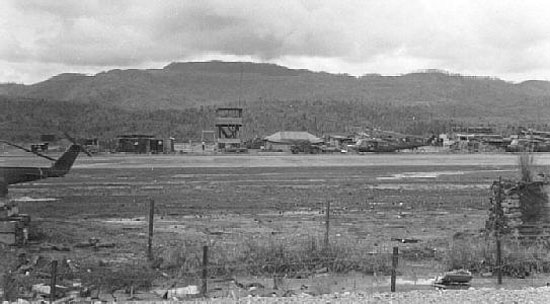
View of Dak To Launch site
Modern Forces: You mentioned that the boots that are hanging on the end of your CAR-15 on page 226 of SOG: Team History and Insignia of a Clandestine Army, Volume 2 were a booby trapped present for your Northern friends. Can you describe how they worked?
Ed Wolcoff: No comment on this.
Modern Forces: Can you recall any other missions that stand out?
Ed Wolcoff: I had 25 missions. Nearly all of them were stand-outs. During my tenure as team leader, RT NY was almost always thrown into the hottest targets - - partly due to the size and weaponry of my team. I only had one dry hole, but that was unintended as the target was supposed to be a NVA division (nobody home). One mission especially worth recounting:
Target was in the same vicinity of the mission where St. Martin was wounded. We were inserted into the wrong LZ and had trackers immediately. Trackers used signal shots to indicate our changes of direction (hammer and anvil tactic); we did a river crossing three times (at extremely high risk) trying to shake them, but they were exceptionally good (most likely enemy SOF counter reconnaissance). Could not ambush enemy crossings, as one side of the river had a concealed road on its periphery and the other side had a network of heavy-use high-speed trails running parallel. Second day continued evasive tactics while trying to continue toward target area. Established night defensive perimeter on a ridge at dark; then heard considerable movement along the ridge approaching us. Called in two Spooky’s and a Spectre (gunships) around our perimeter throughout the night. I recollect that this was on Christmas Eve.
At dawn, changed direction away from the target then attempted to re-approach. Tail-gunner spotted the enemy coming up behind us as we had just passed through an elephant-grass clearing. Team was exhausted by pursuit at this stage. Moved to the rear military crest two ridges from the clearing and called for an air strike on our back trail w/ A-1’s. Took my tail-gunner (who was equipped with a WP rifle grenade) and moved away from the team to mark the enemy’s last known location; moved back to the team after firing the rifle grenade. The enemy came up onto the spot from which we fired the grenade (in an L-formation), rather than where we were actually located, allowing us to spot and kill the squad leader and B-40 rocket man (at the short leg of the “L”. Killed several more enemy along the long leg of the “L”. Quickly moved downhill and along a stream toward an extraction LZ while A-1’s dropped cluster-bombs and strafed with 20mm. Extraction LZ was a bomb crater, requiring our removal by ladder. As we rose up, saw that we were 15-20 meters from the road; could not detect it previously due to vegetation.
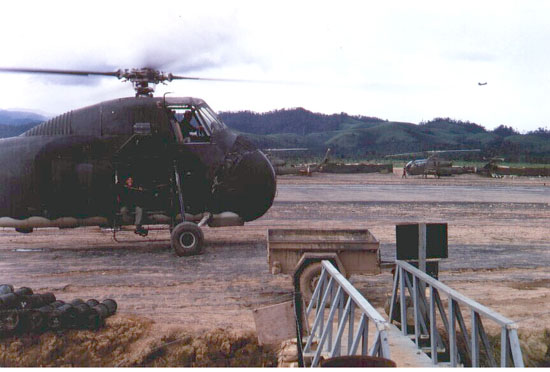
CH-34 at Dakto Launch Site
Modern Forces: Were your indigenous team members Montagyard, Nung or Vietnamese?
Ed Wolcoff: Montagnard, mostly Sedang tribe.
Modern Forces: Did any of them make it out to the States and if so have you ever been in touch?
Ed Wolcoff: None made it out to my knowledge.

Cobra with Dak To launch site in the background
Modern Forces: As part of our living history display this year we are recreating the Dak To launch site, not the whole thing but some key features, can you share any details of the site, its features and what a typical routine was when waiting for insertion or Brightlight?
Ed Wolcoff: Structures included a control tower, a communications shed, a munitions storage conex and a team barrack (the barrack was formerly a mortuary prior to SOG moving in).
Routine: Mostly boredom. Monitored the radio for traffic indicating units in trouble. Would assemble team and prepare for Brightlight launch based on this monitoring. Assisted units pending insertion and upon recovery, as required. Occasionally, assisted air crews with rearming gunships. Conducted a Bomb Damage Assessment mission at the end of my first Dak To standby.
|

